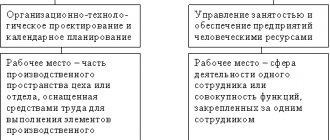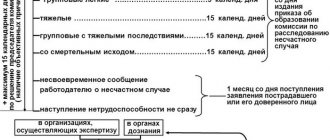Factors
Safe organization and maintenance of the workplace is characterized by the following parameters:
- temperature, exchange, air humidity, illumination, cleanliness, operating mode;
- the state of labor discipline;
- dimensions of the production site, equipment, production inventory (racks, containers, stands);
- the specific placement of inventory, equipment, labor objects (units, workpieces, parts) and tools that ensure rational movements of the employee;
- the contents of the workplace together with the devices and tools that are needed to implement the technological process;
- the presence of production, accounting and technical documentation: drawings, process maps, work order instructions, tool book, brand;
- providing the workplace with workpieces, parts, materials, technical control, repair of fixtures and equipment if necessary.
General terms
It is wrong to think that office work is conducive for employees. The head of the company is obliged to familiarize employees with existing dangers and risks of injury.
List of comfortable conditions:
- Temperature conditions. For the temperature to correspond to the norm: in winter - from 22 to 240 C, and in hot weather - from 23 to 250 C. If the indicator increases or decreases, then working becomes uncomfortable. If the temperature is exceeded, it is allowed to work for no more than 6 hours, and if it drops, it is necessary to take all measures to heat the room.
- Illumination. To ensure impeccable conditions, it is recommended to follow the illumination standard of 300 -500 lux. If a negative view enters the work area from the window, the employee’s work is disrupted. Curtains should be hung on the window. If the latter are absent, then employees can count on a reduced working day and added days to their vacation, otherwise a fine will be imposed on the employer.
- Noise level. According to regulations, noise levels above 80 dB are a violation of occupational safety requirements. As a rule, in this case, employees must be provided with headphones or earplugs.
Work in the office should begin with training.
Poster on labor safety training
Table 1. Types of occupational safety briefings
| Type of instruction | Description |
| Introductory | It is carried out before an employee is hired to work in an office company. The person is not yet employed and does not know the nuances of the work process, so you first need to talk to him, ask a few questions, and then sign in the journal. It is conducted by an occupational safety specialist who has a certification noted in the certificates. |
| Primary | Before starting to perform production tasks, you need to make sure that the employee has knowledge of all the nuances of working in the office. To do this, the manager conducts an initial briefing, which stipulates all the nuances of work at a given place, including familiarization with the special assessment card for working conditions. |
| Repeated | As time passes, the employee begins to forget about his own safety and, in order to remind him of basic measures, regulations provide for periodic conversations, that is, reminders about safety. This type of instruction is provided for this purpose. |
| Unscheduled | It is carried out if an emergency situation occurs in an office company. When replacing or upgrading equipment, if new occupational safety instructions have been introduced or new norms or rules have been regulated, if an accident has occurred or circumstances have arisen in which there was a threat to human life, then an unscheduled meeting is held. Employees are informed of the requirements prescribed by regulatory acts on occupational safety. |
| Target | This type of instruction is regulated in cases where an employee is sent to engage in another type of activity. For example, for cleaning the area or watering the lawn. It is not necessary to conduct certification in these areas, but it is necessary to provide instructions. |
All types of briefings are regulated by state standards.
The maintenance of the workplace must comply with health standards, as well as the most efficient use of employee energy. Standards for air temperature, air circulation, placement of inventory and equipment, and room illumination have been developed.
When designing workplaces, the requirements of technical aesthetics must be taken into account. If the inventory and equipment meet the aesthetic requirements in color and shape, you can count on a significant simplification of human labor.
Standards for accommodating employees in office premises
Sanitary and epidemiological rules and standards”, approved by the Chief State Sanitary Doctor of the Russian Federation on May 30.
2003: The area per workplace of an employee who spends more than four hours a day at a computer must be at least 6 square meters.
m (if the computer has a monitor based on a cathode ray tube) or 4.5 sq.
https://youtu.be/3RJ8QRV5G-w
If the office fails to comply with SanPin requirements, the employee has the right to appeal to the employer with a request to eliminate the cause of the violations and comply with the established requirements. If superiors ignore requests from subordinates, they have the right to file an application with Rospotrebnadzor or even the prosecutor’s office. Upon receipt of the complaint, an investigation will be carried out using the necessary measures.
Hiring Labor {amp}gt; Occupational safety {amp}gt; Requirements for an office worker's workplace: basic rules for organizing the workspace
SanPiN (sanitary rules and regulations) obliges workers and office managers to comply with certain rules for organizing premises and workspace.
The employer must provide all employees with comfortable conditions. Employees, in turn, undertake to maintain cleanliness and not load the table with unnecessary things.
The area of the workplace must comply with the standards.
We invite you to familiarize yourself with dangerous and harmful production factors that can affect the driver of a passenger car
The employer, among other things, is responsible for the arrangement of the work premises. Unfortunately, few office employees know what working conditions they are entitled to by law. Therefore, they sit on broken chairs in a dark, damp or stuffy room.
And if there is an air conditioner installed back in the days of Tsar Gorokh, then it makes worse noise than a Soviet refrigerator due to multiple breakdowns during operation. Such conditions distract from the main activity, increase irritability, fatigue and, as a result, reduce performance.
So, the main requirements that SanPin imposes on the organization of office space:
- optimal temperature in winter and summer. In the cold season it should not be lower than 22 degrees, in the warm season - no higher than 25.
Otherwise, working becomes no longer comfortable. Regardless of the time of year, the temperature should be between 20-28 degrees. If the employer cannot provide optimal air temperature, then he must officially reduce the working day (and no overtime);
- one employee with a computer is entitled to 4.5 sq. m. of working space. If an employee works at a PC, then the optimal area of his workplace is 4.5 square meters. m. or 6 sq. m.
The exact footage depends on the model and dimensions of the device, as well as the presence of other equipment at the workplace - a scanner, printer, and so on;
- excellent lighting is the key to good vision. The employer can use both artificial and natural light sources. So, for example, you can initially rent a bright room with large windows and not worry too much about lighting during the day.
Light from natural and artificial sources should fall in the same direction, so LED lamps are best placed parallel to the windows.
The windows themselves should face mainly north and northeast, so that the sun does not blind your eyes. In general, lighting should be at least 500 lux.
With this indicator, you can work on a PC, read and write. 300 lux is also suitable for office work, but with such lighting it is impossible to see small details;
- humidity within employee workplaces should not exceed 60%, in other rooms (buffets, toilets, warehouses) - 75%. It is highly desirable that the office have an air conditioner, an air purifier (humidifier), and a ventilation system;
- Office equipment should not be stored in basements: printers, scanners, and so on. It can be placed next to workplaces. Office equipment should be placed at a distance of 60 cm from the nearest table or wall. There must be at least 1 m of unoccupied space in front of it;
- noise in an office space should not exceed 80 dB. For comparison, a telephone conversation’s “noise” is approximately 50 dB;
- Chairs for office workers should be height adjustable and have a reclining backrest.
This is necessary in order to optimize the chairs for each employee, based on their height and weight.
Conducted at certain intervals.
Certification is mandatory every 5 years. Representatives of an independent company or trade union come to the office and evaluate the workspace based on all established criteria.
If union workers find any violations and inconsistencies, a fine is imposed on the employer.
Certification is, roughly speaking, a procedure during which the workspace is checked for violations. Various instruments are used to measure air temperature and humidity.
The furniture, the position of workplaces, and so on are also inspected. In general, everything is checked up and down.
An employee can independently complain about violations of SanPiN or about a long-term (more than 5 years) lack of inspection of workplaces.
To do this, you must first contact your employer with specific complaints.
Moreover, you can simply request a description of your workplace in accordance with all sanitary standards.
If the employer avoids a direct answer, then you can safely contact the State Labor Inspectorate. The only downside is that anonymous complaints are not possible.
https://youtu.be/19k0iXGCqtw
If there are no conditions, the working day may be reduced.
If the rules for organizing the workspace are violated, employees are granted certain privileges. For example, shortening the working day at low or high room temperatures.
If in the warm season the temperature is 28.5 degrees, then the working day is reduced to 7 hours. At 29 degrees you can only work for 6 hours, at 29.5 - 5.5 hours.
Employees are provided with a dining space, the organization of which depends on the number of workers in the office. Even if the company employs less than 10 people, there should still be a place for eating - at least 6 square meters. m. and with a dining table.
The headquarters, consisting of 10 employees, already requires a separate dining room of at least 12 square meters. m., and of 30 - a canteen-distributing area.
If the office bathroom does not function, then employees can go home with peace of mind or demand compensation.
Employees can turn any violations in the organization of their workspace to their advantage.
But, of course, it is much better if the employer takes care of the improvement of a comfortable office that meets all the rules of SanPiN.
From this video you will learn about workplace organization.
Select it and press Ctrl Enter to let us know.
https://youtu.be/bOEoienTMYs
Significance of the process
Keeping a safe workplace has a positive impact on productivity.
The results of statistical studies indicate that with proper organization of the workplace, you can count on high-quality and efficient work by the employee.
After analyzing work processes, it was found that the most advantageous position is a sitting position. That is why the rules for maintaining a workplace include the issue of placing seats in production, where the force is about 5 kg. If the working force exceeds 10 kg, work should be performed only in a standing position.
In case of equal convenience between two provisions, the employee has the right to independently choose one of them.
Normative base
If a specialist spends 12 hours or more a day on a PC, then occupational diseases begin to develop. Organization of the work place is very important.
For the normal activities of office workers, regulatory documents adopted in the Russian Federation apply:
- Each worker is provided with a workplace with a volume of space of at least 19.5 m3 and an area of 6 m2. The employer should not deviate from these indicators in order not to violate the requirements of regulations.
- If you stay indoors for more than two hours at a time, then natural lighting is necessary. Computers can be installed in basements, but this is possible only with the production technology that is installed in the organization. The orientation of the windows is determined by north or northeast. It is necessary to hang curtains or blinds at the openings so that the sun's rays do not interfere with the work process.
- The device of grounding and grounding helps to eliminate the impact of harmful components on employees during the shift. Do not allow the PC to be installed in places where there are power lines and high voltage cables.
- Every day it is necessary to ventilate the room and perform wet cleaning so that dust does not settle on the computer and then become electrified.
- From the rear side, desktops must be installed at a distance of 1.2 m. A distance of at least 2 m must be maintained between monitors.
- The light should fall on the desktop from the left side, this is the predominant direction.
- A distance of 0.6-0.7 m should be maintained from the monitor to the eyes, but it must be taken into account that this distance should not exceed 0.5 m.
- Screens cannot be turned to face each other. This is a clear violation of the rules.
- Chairs should be adjustable to ensure ease of reading and placing information. You need to know that your neck and spine are comfortable.
- A footrest must be provided. The width is 0.3 m, and the depth is no less than 0.4. For height adjustment up to 0.15 m. The surface should not be smooth to prevent feet from slipping.
We suggest you familiarize yourself with what the orange stripe on the road means
https://youtu.be/Eo739JvBhds
The requirement is determined by hygiene standards and is mandatory for all office managers.
Responsibility for non-compliance with SanPin
If during the inspection violations of sanitary standards are revealed, the employer will face administrative punishment in the form of a fine, disqualification and (or) suspension of activities.
For the first violation:
- officials and entrepreneurs will receive a warning and pay a small fine of 2-5 thousand rubles;
- organizations will get off with a warning and a fine in the amount of 50-80 thousand rubles.
In case of repeated violation:
- officials will face a fine of 30-40 thousand rubles and disqualification for 1-3 years;
- Individual entrepreneurs will receive a fine in the amount of 30-40 thousand rubles, and business activities will be stopped for 3 months;
- organizations will pay a fine of 100-200 thousand rubles, and their activities will be stopped for 3 months.
https://youtu.be/SiRiHs9xaUA
Where to start
Office employees begin work after conducting a special assessment of working conditions or after briefing the immediate managers of the companies. Conducting a special assessment is based on carrying out activities in order to identify hazardous factors and harmful effects on the body.
How the working day begins:
- Before you begin performing tasks, you need to inspect the workplace for the presence of grounding, a footrest, adjust the chair for your own comfort, and the absence of exposed wires.
- If any deficiencies are discovered, the supervisor must be informed so that action can be taken. Work should not begin until everything is corrected and compliance is brought to standard levels.
- Employees are required to be informed about all the nuances in the workplace that may interfere with normal work.
Labor protection regulations
The basic occupational safety requirements when working in an office are as follows:
- Compliance with the standards and rules of the fire safety regime at the enterprise according to the operating conditions.
- Ensuring hygienic conditions for lighting, placement of workers on site, determining the number of employees based on area per 1 m2, air humidity and temperature parameters, installation and placement of computer equipment, time spent at the computer.
- Ensuring requirements for the safe use of computers, including the presence of grounding checks, handling of technical devices, the absence of sharp edges and corners on the PC; there should be no glass, and this material can only be replaced with plexiglass.
The provisions are based on sanitary standards and hygienic requirements.
Requirements for production premises and workplaces
General sanitary and technical provisions in relation to production premises are set out in SNiP.
Primary requirements:
- All companies must have places where waste will be dumped;
- premises must be clean and regularly cleaned;
- in boiler rooms, as well as in all similar heated rooms, the formation of condensation on the internal surfaces of the walls is unacceptable;
- floors should be made of materials that can be easily cleaned (for example: tile, asphalt or wood);
- the organization must also have dressing rooms, showers, smoking rooms and other sanitary facilities;
- The company must have a good water supply for various production purposes.
https://youtu.be/RxPWeAKav28
Labor protection requirements before starting work
Before starting to perform tasks, the employee must:
- Conduct an external inspection of the place of his work and put it in proper order.
- Adjust the lighting mode, make sure that the brightness of the light is sufficient, and that there are no reflections or glare on the screen; the luminous flux coming towards it should also not hit the monitor.
- Check whether the equipment is correctly connected to the power supply.
- Use a special cloth to wipe the computer monitor and surge protector so that static electricity does not accumulate during operation.
- Check and adjust the installation of the computer chair, position the monitor at the desired angle in a given plane. There should be no tension in the body and the eyes should not get tired when performing management tasks.
If you discover any shortcomings and if you are not sure that everything during preparation was done correctly, then you must inform your manager or eliminate the shortcomings yourself, only after starting work.
During the execution of a production task, the PC user is obliged to:
- Perform only the work that was assigned to him by the manager, as well as for which he was instructed.
- In the process of performing tasks, it is necessary to know and comply with the norms prescribed by sanitary rules and regulations.
- When entering information, select the optimal physiological mode, that is, set the desired brightness on a white background.
- It is necessary to take breaks during work, that is, perform industrial gymnastics or know a set of exercises specially designed to relieve the muscles of the neck, shoulder joints and head.
- The distance from the monitor to the operator’s eyes should be from 0.5 to 0.6 m.
Poster about working safely with a computer
Several requirements for what not to do when performing tasks:
- If the power is turned on, do not touch the back panel of the system unit to avoid injury from static electricity or insulation breakdowns.
- When the power is on, do not switch connectors or cables.
- There should be no different papers or other objects on the top panels.
- Do not allow moisture to get on the system unit or monitor, keyboard, photocopier, printer or disk drive to avoid electric shock.
- If the equipment has been outside for a long time at sub-zero temperatures, it is not allowed to be turned on immediately. It is necessary to let the equipment stand at home for six hours.
- A PC user cannot repair a PC on his own, as he is not certified to perform this work, and this can lead to unpredictable consequences.
If the listed regulations are followed, the safety of technological processes will be ensured.
If an emergency situation occurs at the workplace, an employee of an office company must fulfill several requirements to prevent its development:
- If for any reason the wires through which power is supplied to the computer are broken, or a fire occurs, then this factor must be reported to the immediate supervisor, the person on duty, and the PC must be immediately de-energized.
- If a person finds himself in a high voltage zone, then it is necessary to free him, that is, turn off the electricity and begin providing first aid. Everyone should be able to provide the latter.
- If there is a failure in working with the PC, you need to report the incident to the duty service responsible for repairs.
- If there is pain in the eyes, pain in the pupils, or the state of health has deteriorated sharply, then it is necessary to inform the manager, leave the workplace, and go to the first aid station so that first aid can be provided.
- When electrical equipment accidentally catches fire, it is necessary to de-energize the system, call the fire service and begin to extinguish the fire with carbon dioxide and powder. By decision of the manager, it is necessary to evacuate to a previously established place.
https://youtu.be/ybRUk9OSyuU
Every employee must know the sequence of activities to ensure that no emergency situation has developed.
If the working day is successfully completed, then it is worth tidying up the place of work:
- Turn off the equipment involved in the work; the general switch should also be switched to inoperative mode. The latter is described in the operating instructions.
- If there were any shortcomings or malfunctions, you must report them to your immediate supervisor. It is better to prevent such circumstances than to wait for trouble.
Following simple rules leads to safe work.
If the employer does not provide the employee with a safe workplace, an administrative fine will be imposed on him. And if an employee is injured in the workplace, the guilty official who did not provide proper working conditions may be held criminally liable.
But sometimes workers do not comply with labor protection requirements, despite the fact that all the necessary instructions have been explained.
If you have difficulties resolving issues regarding labor protection and workplace organization, you can contact specialists at any time who will help you find a way out of the current situation.
We invite you to familiarize yourself with the characteristics of the tractor driver from the place of work, sample
What is workplace organization? The maintenance of workplace organization is a prerequisite for increasing the efficiency of employees. In addition to muscular costs, the load on a person’s visual-nervous apparatus increases significantly during work. With rational, ergonomic design of workshops, using reasonable coloring of inventory and equipment, it is possible to increase the tone of workers and increase labor productivity with minimal energy costs.
The correct selection of colors helps reduce fatigue and is considered an excellent prevention of conflicts in the workplace.
Selection of materials
Statistical studies conducted in production have confirmed the possibility of increasing labor productivity by 15-20 percent if the above factors are observed.
Green-blue and yellow colors have a positive effect on the central nervous system. It is advisable to paint the upper part of the walls, ceilings, and window blocks in light shades: cream, white, blue. Light colors reflect more than half of the sunlight, so there is a significant saving in electrical energy.
The racks installed in production workshops match the color of the main equipment. Contrasting shades are chosen for levers and buttons on control panels.
What is safety precautions in an enterprise?
These are rules whose compliance guarantees the life and health of workers at a specific production facility. Occupational safety and health is the responsibility of the employer, which is imposed on him by a number of regulations, including:
- Labor Code;
- Federal Law of July 24, 1998 No. 125-FZ;
- Federal Law of December 28, 2013 No. 426-FZ;
- Order of the Ministry of Labor dated December 29, 2014 No. 1197;
- Government Decree No. 1160 dated December 27, 2010 and a number of others.
Occupational safety (OSH) is associated with the prevention and prevention of injuries and occupational diseases. At the end of 2018, 4,479 serious accidents were recorded in Russia, 1,158 people died. The Ministry of Labor in its message did not specify who is to blame for the deaths of workers, but, as a rule, the main cause of death is the human factor.
- save the lives of yourself and other workers;
- not to violate the law and not to cause harm to people’s health with subsequent administrative (Article 5.27 of the Code of Administrative Offenses) or criminal liability (Article 143 of the Criminal Code of the Russian Federation);
- do not violate labor discipline and maintain all benefits and additional payments at the workplace;
- keep your job, since violation of safety regulations by the Labor Code of the Russian Federation provides for termination of the employment contract (Article 81 and Article 192 of the Labor Code of the Russian Federation).
The conditions on which labor protection and the organization of the workplace depend are:
- features of the technological process;
- type of equipment used;
- level of mechanical and technical equipment of labor;
- level of division of labor.
The safety of his working conditions directly depends on how organized an employee’s workplace is. For example, the floor in the room where a company employee works must be level, without recesses or holes. There must be a fire extinguisher and an evacuation plan in the room, and the employee must be briefed.
In the office, the area of which is 20 sq.m. You cannot organize 7 jobs. This is because there are rules according to which one employee is entitled to at least 6 square meters. m. of working space.
Safety in the workplace of a worker depends entirely on the skills of a specialist in a particular profession, as well as the ability to use basic equipment. Before a person begins to perform his duties, he must undergo training. An employee who has been working at an enterprise or firm for a long time introduces the newcomer to the features of the profession.
A safe working environment directly affects the efficiency and quality of work performed by employees. Therefore, initial instruction should be carried out not for show, but with really high quality. Most often, this task is entrusted to an individual employee with extensive experience in the enterprise. Proper information allows you to avoid accidents at work, as well as deterioration in the health of personnel.
https://youtu.be/9jfBTVHuSLc
Fire safety in the workplace deserves special attention. Instruction in this area is most often carried out by a person who has the appropriate education. The new employee must understand how to behave in the event of a fire. The briefing includes a description of basic safety precautions, as well as the location of fire panels.
In medical institutions, employees who enter work are treated with special attention. A person without special education cannot work in a hospital or private clinic. Junior medical staff may have secondary education. Only a specialist with a higher education can be hired as a doctor.
Before a doctor or nurse begins to perform their direct duties, they are required to undergo an examination by key specialists. Employees should not suffer from sexually transmitted diseases, as well as airborne diseases. Specialists who have mental disabilities are not allowed to perform their duties. A nurse's safety in the workplace largely depends on her own health.
Medical personnel must perform their duties in accordance with the regulations of the medical institution. This is especially important for manipulative nurses. All injections and IVs must be given strictly according to schedule. Failure to comply with this rule threatens to worsen the patient's condition. Medical personnel must perform all manipulations wearing sterile rubber gloves.
A specialist who goes to work in a medical institution is obliged to comply with internal regulations. Discipline must be observed, as well as fire safety in the workplace. Nurses and doctors cannot drink alcohol during the working day. And you can only smoke in specially designated areas.
Any construction site, regardless of the type of work performed, poses a huge danger not only to the company’s employees, but also to passers-by. It is here that you can observe many complex mechanisms, the management of which requires special skills. A simple construction crane can cause an accident.
Before starting the construction of any facility, the engineer must plan the entire work process step by step. Complex equipment must not be allowed to pose a danger to workers during operation. Proper storage of building materials is also of considerable importance. There should be no strangers on the construction site while the crane is operating.
On a construction site, special attention is paid to uniforms. Labor safety in the workplace is ensured with the help of a special helmet and overalls. The headdress is made of high-strength plastic. Such material can protect against metal and brick fragments. The overalls should be selected in size so as not to restrict the worker’s movements. Clothes are made from special materials that are easily cleaned from construction waste and dust.
Any sewing enterprise is a high-risk area for workers. Presses, cutting objects, and sewing equipment pose a health hazard. Safety in the workplace of a worker depends primarily on his compliance with basic rules. Before starting their duties, each employee must check the serviceability of the equipment with which they will have to work. If the equipment does not function correctly, this should be reported to a mechanical engineer.
All work items on the table must be in their place. Needles, scissors and other sharp and cutting objects should be hidden in special cases. Sewing equipment should not be left unattended. If you need to go away, needles and scissors are put in a special box in the table. Safety at the worker's workplace directly affects the life and health of other employees of the clothing company.
Particular attention is paid to the clothing of people who work with sewing equipment. Special uniforms are not always provided. Despite this, each employee is required to have a hat, apron and sleeves. Such clothing allows you to minimize the possibility of an accident. Employees who have long hair must hide it under a hat. A braid caught under a sewing machine needle can cause serious injury.
We invite you to read: Normal working hours cannot exceed?
While working at sewing equipment, it is prohibited to be distracted by extraneous conversations with colleagues or communicate on topics not related to the production process. Loss of attention, at best, threatens poor performance of the task. At worst, it will cause harm to health. Proper training will help ensure workplace safety. Every employee must pass it before starting to perform their official duties.
A carpenter has to work with flammable material and use sharp tools. Therefore, safety requirements are quite high. Only adults who have undergone appropriate training may be allowed to perform duties. A specialist is required to confirm his skills with a document - an education diploma.
Carpenters can only perform the work that is prescribed by the job description. At the same time, specialists cannot deviate from the internal labor regulations. Only in this case will safety measures in the workplace be observed, and duties will be performed correctly and in a timely manner. Compliance with internal routines also contributes to the normal completion of tasks by colleagues.
A carpenter's job involves processing wood using special equipment. The base material is flammable. Therefore, every carpenter should know the fire safety rules by heart. An employee of the enterprise must know where the fire panel is located and how to call the emergency service. If you have to work indoors, every employee should know where the fire exit is.
Necessary to avoid accidents.
The leader is responsible.
The legislative framework
- The issue of square footage per person in office premises is regulated by sanitary and epidemiological rules and regulations (SanPiN), which were developed in accordance with the Federal Law “On the sanitary and epidemiological welfare of the population” dated March 30, 1999. No. 52 and the Regulations on state sanitary and epidemiological regulation, approved by Decree of the Government of the Russian Federation of July 24, 2000 No. 554.
- As for the hygienic requirements for personal electronic computers (computers), they are specified in the document SanPin 2.2.2/2.4.1340-03.
- Also, there are regulatory requirements for square footage in offices in the code of rules SP 118.13330.2012 “Public buildings and structures.”
When is additional training provided?
There are several options for instructions, each of them uses its own instructions.
https://youtu.be/2cUEhHy3HFw
The primary type is carried out before the actual performance of official duties. It is mandatory for all categories of employees, regardless of working conditions. It will include questions regarding a safe route to the workplace, methods and technologies for performing direct job duties, precautions, as well as requirements for clothing, footwear, and appearance when performing work functions.
Induction training is used in situations where an employee is hired. A second version is needed in cases where emergency situations arise that demonstrate employees’ incomplete knowledge in the field of labor protection, organization and workplace safety.
In addition, refresher training is required after emergencies occur. Their goal is to periodically update the knowledge of employees. The frequency of repeated briefings is once a quarter.
Unscheduled briefings are carried out when there are changes in technological chains. For example, when installing new equipment in workshops, the requirements for workplace organization change, so an occupational safety specialist conducts unscheduled training for workers. The reason for an unscheduled briefing may be an accident at work, the cause of which was a violation of safety regulations or improper organization of the workplace.
Targeted briefings are intended for specific tasks, the implementation of which is associated with a serious danger to the employee’s health. They are carried out as needed. For example, theoretical classes are conducted with the skills acquired in practice. The results of the briefing are recorded in a special journal, and the employee puts a signature confirming the reality of its implementation.
Organizing a high-quality and safe workplace is the task of an employer who thinks about the health of its employees. Activities associated with this process pay off with high employee productivity, increased company prestige, and also lead to additional material profit for the company.
Instruction on the topic: “Labor safety in the workplace” must be carried out not only with newly hired employees, but also with those who have been working at the enterprise for quite a long time. This is to avoid accidents and remind workers of basic safety precautions when working with complex machinery.
Additional training may also be needed when new legislation is introduced that describes workplace safety. If the current requirements have been changed, all employees of the enterprise must be informed about this. Employees cannot begin to perform their duties until they sign a document confirming completion of the training.
When changing or reorganizing work technologies, existing employees must be informed about this before the start of the work shift. This is especially important if you have to work on complex electrical equipment.
Additional training is required if an employee violates safety regulations in the workplace. Such behavior may lead to an accident or deterioration in the health of other employees of the enterprise. The first violation is accompanied by a fine and additional information about the rules of conduct in the workplace. In the future, a person who does not comply with safety regulations may be fired by the boss without warning.
https://youtu.be/29zl961Ngt4
Features of workplaces
Depending and workplace organization will depend
In hazardous production conditions, labor protection requirements will differ from office work conditions.
For example, the noise level in the workshop must comply with the standards established by law ; exceeding the permissible value can seriously affect the health of the employee. Or, the machine on which the employee works must be specially equipped.
At the same time, lighting must also comply with labor protection legislation . If an employee works in a room where there are no windows and no light enters the office, then these working conditions will be considered harmful.
The creation of a workplace directly depends on the job duties that the employee performs . The main requirement for an installer of high-rise buildings is to ensure safety when performing work; the equipment must meet all requirements and not be worn out.









